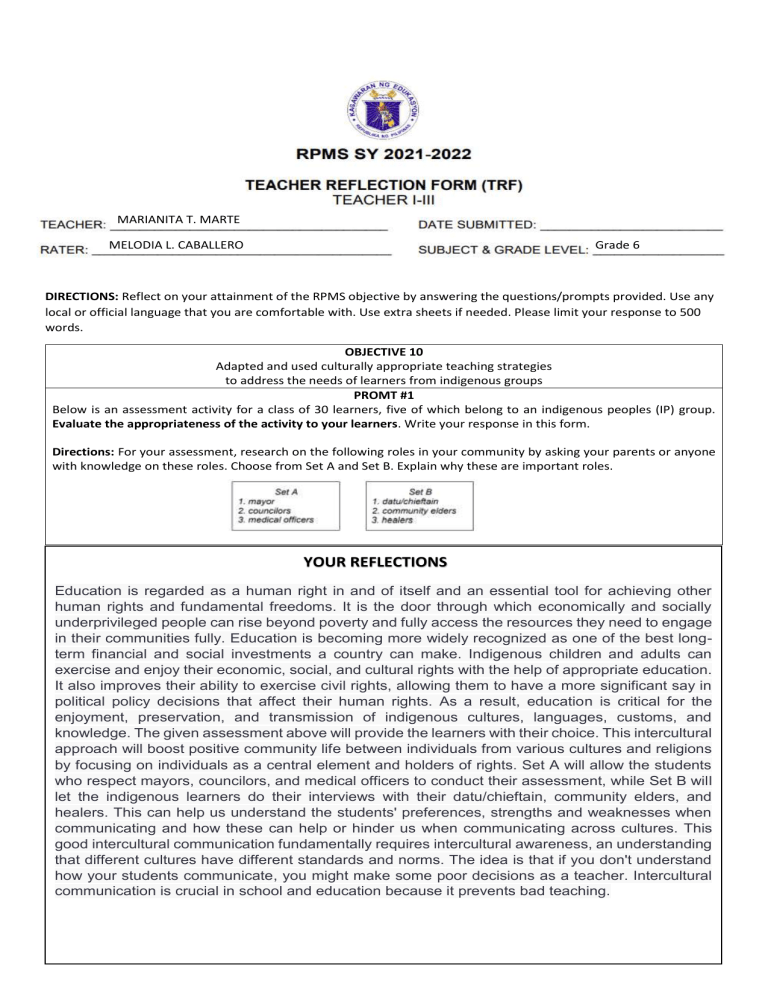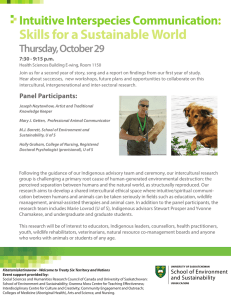
MARIANITA T. MARTE MELODIA L. CABALLERO Grade 6 DIRECTIONS: Reflect on your attainment of the RPMS objective by answering the questions/prompts provided. Use any local or official language that you are comfortable with. Use extra sheets if needed. Please limit your response to 500 words. OBJECTIVE 10 Adapted and used culturally appropriate teaching strategies to address the needs of learners from indigenous groups PROMT #1 Below is an assessment activity for a class of 30 learners, five of which belong to an indigenous peoples (IP) group. Evaluate the appropriateness of the activity to your learners. Write your response in this form. Directions: For your assessment, research on the following roles in your community by asking your parents or anyone with knowledge on these roles. Choose from Set A and Set B. Explain why these are important roles. YOUR REFLECTIONS Education is regarded as a human right in and of itself and an essential tool for achieving other human rights and fundamental freedoms. It is the door through which economically and socially underprivileged people can rise beyond poverty and fully access the resources they need to engage in their communities fully. Education is becoming more widely recognized as one of the best longterm financial and social investments a country can make. Indigenous children and adults can exercise and enjoy their economic, social, and cultural rights with the help of appropriate education. It also improves their ability to exercise civil rights, allowing them to have a more significant say in political policy decisions that affect their human rights. As a result, education is critical for the enjoyment, preservation, and transmission of indigenous cultures, languages, customs, and knowledge. The given assessment above will provide the learners with their choice. This intercultural approach will boost positive community life between individuals from various cultures and religions by focusing on individuals as a central element and holders of rights. Set A will allow the students who respect mayors, councilors, and medical officers to conduct their assessment, while Set B will let the indigenous learners do their interviews with their datu/chieftain, community elders, and healers. This can help us understand the students' preferences, strengths and weaknesses when communicating and how these can help or hinder us when communicating across cultures. This good intercultural communication fundamentally requires intercultural awareness, an understanding that different cultures have different standards and norms. The idea is that if you don't understand how your students communicate, you might make some poor decisions as a teacher. Intercultural communication is crucial in school and education because it prevents bad teaching. DIRECTIONS: Reflect on your attainment of the RPMS objective by answering the questions/prompts provided. Use any local or official language that you are comfortable with. Use extra sheets if needed. Please limit your response to 500 words. OBJECTIVE 10 Adapted and used culturally appropriate teaching strategies to address the needs of learners from indigenous groups PROMT #2 Design a lesson plan for your class that integrates aspects of indigenous peoples (IP) culture using national mandates on indigenous people’s education (IPEd) as reference: Republic Act No. 8371 or the Indigenous People’s Rights Act of 1997 DepEd Order No. 62, S. 2011 or the Adopting the National Indigenous Peoples (IP) Education Policy Framework DepEd Order No. 32, S. 2015 or the Adopting the Indigenous Peoples (IP) Education Curriculum Framework. The integration of IP culture in the lesson plan must be highlighted and annotated in this reflection form. Attach your lesson plan here. YOUR ANNOTATIONS




